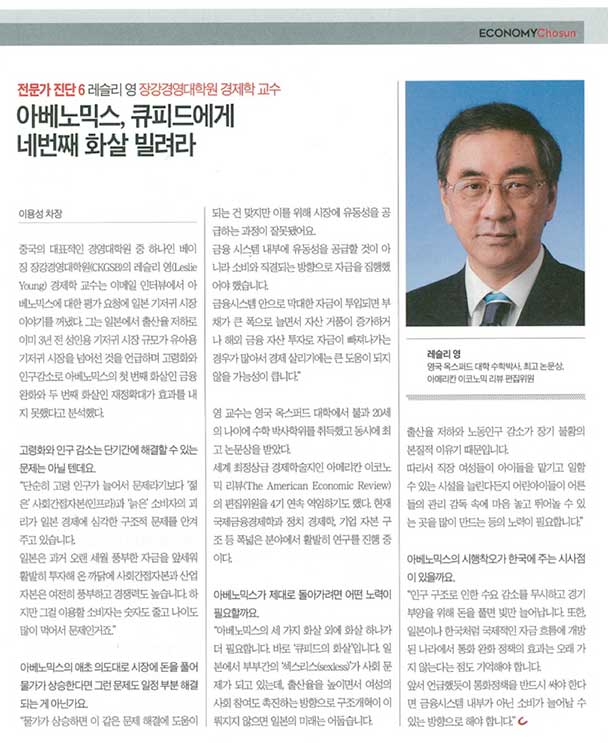It has been three years since Shinzo Abe, the Prime Minister of Japan, first advocated his ‘Abenomics’ strategy to overcome Japan’s lost two decades with expansionary economic policies. Abenomics is based upon the “three arrows” of fiscal stimulus, monetary easing and structural reform. However, today, Japan faces a crisis as the yen is getting stronger due to a low exchange rate during a global recession. In the cover story of Economy Chosun’s recent edition, Professor Leslie Young and renowned economic gurus from China, the US, Japan and Korea analyzed the results of Abenomics during the last three years and its impact.
“It failed because it could not get over the aging and population decrease. It needs a ‘fourth arrow’ of Cupid to overcome the low birth rate.”
–Leslie Young, Professor at CKGSB
“I evaluate Abenomics positively, but I think it is still insufficient. Rather than increase rates, Japan should continue fiscal policy for the next two or three years.”
-Paul Krugman, Professor at The City University of New York
“The monetary policy worked, but has reached its limits. Economic stimulation is needed through fiscal policy, instead of rate increases.”
-Joseph Stiglitz, Professor at Columbia University
Professor Young discussed the diaper market in Japan during a written interview about Abenomics. He mentioned the fact that the adult diaper market exceeded the baby diaper market three years ago in Japan due to the country’s birth rate drop, aging and the population decrease. As a result, he said that Abenomics’ first arrow of monetary easing policy and the second arrow of fiscal stimulus had not worked.
Q. It doesn’t look like the aging and population issues can be solved in a short period of time. Would you agree?
Prof Leslie Young: The problem is the gap between ‘young’ infrastructure and ‘old’ consumers, not merely an elderly population increase. Through heavy investment by earlier large generations, Japan has built up a large stock of industrial capital and infrastructure, i.e., it has a relatively “youthful” industrial structure with a lot of physical capital in forms that are years away from final consumption. When the population stabilizes then declines, there will be less demand, not only for consumption goods, but also for capital goods and infrastructure. These ‘younger’ stages of production will eventually have to be scaled down in proportion to the reduced demand for consumption goods. This leads to economic stagnation.
Inflation could alleviate the imbalance problem: it would raise the purchasing power of younger generations of workers relative to retired workers, effectively expropriating the latter but stimulating the economy. However, this has not halted deflation because the money is created through injection into the financial system. Unfortunately, the money is either staying there, creating asset inflation without stimulating the economy, or heading abroad to be invested in financial assets overseas. They should have injected money directly into consumer budgets, not through the financial system.
Q. To which direction should Abenomics be headed if it is to work?
Prof Leslie Young: What is really needed is a fourth arrow, namely, that of Cupid for childless couples. Structural reform to raise the birth rate and encourage the participation of women in society is essential since the low birth rate and labor force reduction are the fundamental reasons for the prolonged recession.
Q. What is the implications of Abenomics for other countries?
Prof Leslie Young: The lessons of the above analysis are as follows:
To read the original Korean article in the Economy Chosun, please click here.
